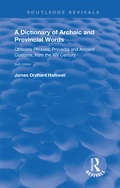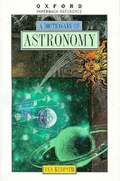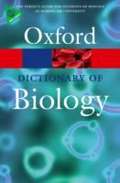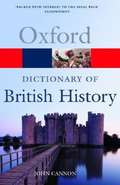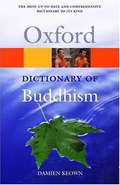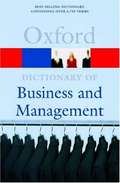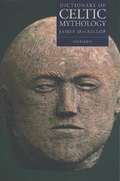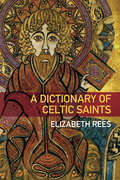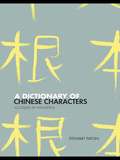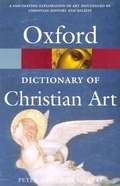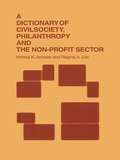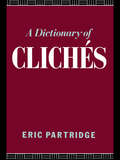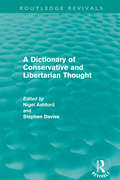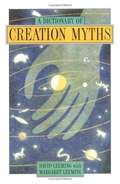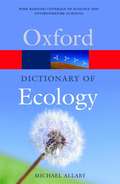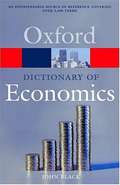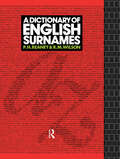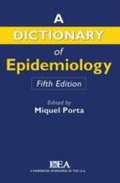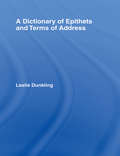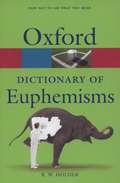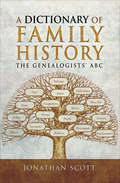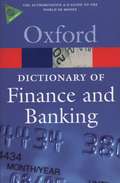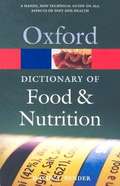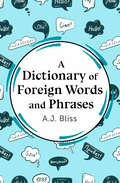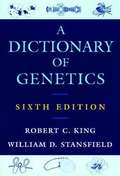- Table View
- List View
A Dictionary of Archaic and Provincial Words: Obsolete Phrases, Proverbs, and Ancient Customs, from the XIV Century (Routledge Revivals)
by James Orchard HalliwellSo far I may be permitted to speak without intrenching on the limits of criticism. A work containing more than 50,000 words, many of which have never appeared even in scattered glossaries, and illustrated, with very few exceptions, by original authorities, much contain valuable material for the philogist, even if disfigured by errors. With respect to the latter contingency, I am not acquainted with any glossary, comprising merely a few hundred words which does not contain blunders, although in many instances the careful attention of the editor has been specially directed to the task. Can I then anticipate that in a field so vast that no single life would sufice for a minute examination of every object, I could have escaped proportionate liabilities? That such may be pointed out I have little doubt, notwithstanding the pains to prevent their occurrence, but it will be manifestly unfair to make them the test of merit, or thence to pronounce a judgement on the accuracy of the whole.
A Dictionary of Astronomy
by Ian RidpathAstronomy is expanding almost as rapidly as the universe itself, and the proliferating scientific jargon can sometimes baffle even the most dedicated amateur. Now, in some 4,000 concise, up-to-date entries, this dictionary cuts a clear path through the maze of complex technical language, offering full, clear definitions drawn from all aspects of astronomy. Compiled by Ian Ridpath, a fellow of the Royal Astronomical Society, and an expert team of contributors, A Dictionary of Astronomy contains the most recent entries from astrophysics and cosmology to galaxies and time. Here are succinct definitions for the Big Bang theory, comets, eclipses, Magellanic Clouds, Mars, quasar, relativity, and variable stars. Entries on telescopes and other measuring devices, observatories, space missions, and recently named Solar System objects show how astronomers have explored the universe. The Dictionary also provides biographical entries on eminent astronomers from Copernicus to Edwin Hubble. From black hole to white dwarf, and from spiral galaxies to solar waves, A Dictionary of Astronomy opens a window on the universe for amateur astronomers everywhere.
A Dictionary of Biology
by Elizabeth Martin Robert S. HineFully revised and updated for the sixth edition, this market-leading dictionary is the perfect guide for anyone studying biology, either at school or university. With over 5,200 clear and concise entries, over 300 of them new to this edition, it provides comprehensive coverage of biology, biophysics, and biochemistry. Features include biographical entries on key scientists and highlighted entries on important topics such as bioinformatics, genomics, molecular evolution, and protein structure, with further reading suggestions. Appendices include classification of the animal and plant kingdoms; geological timescale; major mass extinctions of species; model organisms and their genomes; and Nobel prizewinners - the last two new to this edition.
A Dictionary of British History
by John CannonWhen was the first motorway opened? How did the British acquire Hong Kong? What was the book of sports? What prompted the Cat and Mouse Act? How long did the Hundred Years War last? Which queen was "nothing so fair as reported? "Drawing on the highly acclaimed Oxford Companion to British History, A Dictionary of British History, published in the very popular OPR series first in 2001 and now reissued for 2003, is a handy and invaluable reference work essential for anyone with an interest in British history and in need for a compact reference source covering 2,000 years of people, events, and places, and political, economic, local, domestic, military, and social change. In more than 3,600 entries, over 100 specialist contributors describe the people and events that have shaped and defined domestic, political, social, and cultural life in Britain over the past two millennia.
A Dictionary of Buddhism
by Damien KeownA comprehensive dictionary of Buddhism is even now growing in the unconstrained dimensions of the Internet, notes Keown (historical and cultural studies, U. of London). By comparison, his effort is modest: a handy one-volume source for students and general readers seeking concise explanations of the various concepts, names, texts, and terms found in the Buddhist literature. The articles are highly cross-referenced. Appendices include maps, a pronunciation guide, a guide to Buddhist scriptures, and a chronology. Annotation (c)2003 Book News, Inc., Portland, OR (booknews.com)
A Dictionary of Business and Management (4th edition)
by Jonathan LawThe Dictionary of Business and Management is a wide-ranging and informative guide to all areas of business. It features up-to-date coverage of over 6,700 terms from marketing to taxation and accounting, business strategy and international finance. In this new edition, Jonathan Law covers all aspects of marketing, taxation, accounting, investment, banking and internal finance. Including comprehensive coverage of management concepts, theories and jargon, and human resources, the book reflects the increased focus on these areas in modern business. It also covers e-commerce, including up-to-date vocabulary for buying and selling online. The Dictionary of Business and Management has been expanded to cover the expansion of the European Union, and contains a new appendix listing useful websites and addresses for further research.
A Dictionary of Celtic Mythology (Oxford Paperback Reference)
by James MackillopThe full richness of Celtic mythology--legends, sagas, folklore,traditions, places, and personalities--is concisely conveyed in this dictionary.
A Dictionary of Celtic Saints
by Elizabeth ReesThroughout the Celtic world, in Britain, Ireland and France, the early Christian saints left a profound legacy to the history and culture of Northern Europe. This is the first ever dictionary of Celtic saints and is fully illustrated with photographs of where each saint lived and worked, ranging from ruined monasteries to holy wells, and from caves to Roman and Celtic forts. The reader is therefore drawn into the beautiful world which these men and women inhabited, while also being able to trace the history and legend surrounding these early British Christians. Easy to use, with an Introduction and maps to pinpoint the sites described in the text, A Dictionary of Celtic Saints will appeal to anyone interested in history, landscape or spirituality. Based on sound scholarship, it will also be helpful to students of civilisation and culture.
A Dictionary of Chinese Characters: Accessed by Phonetics
by Stewart PatonBy arranging frequently used characters under the phonetic element they have in common, rather than only under their radical, the Dictionary encourages the student to link characters according to their phonetic. The system of cross-referencing then allows the student to find easily all the characters in the dictionary which have the same phonetic element, thus helping to fix in the memory the link between a character and its sound and meaning. This innovative resource will be an excellent study-aid for students with a basic grasp of Chinese, whether they are studying with a teacher or learning on their own.
A Dictionary of Christian Art
by Peter Murray Linda MurrayThe Dictionary of Christian Art, now rebranded in the best-selling Oxford Paperback Reference series, is a unique and fascinating exploration of the art and architecture that has been influenced and inspired by biblical stories and Christian history and beliefs. The Dictionary combines general essays on the periods and styles important in the history of Christian art with lots of shorter entries that describe specific works, artists, themes, and visual images, and which give the reader practical guidance on where in Europe to locate the works described. The Dictionary of Christian Art is a unique and fascinating exploration of the art and architecture that has been influenced and inspired by biblical stories and Christian history and beliefs. Among the many features of this dictionary are: detailed essays on periods and styles in art and architecture, including Byzantine, Renaissance, Baroque; general background to the Old and New Testaments, and to Christian tradition and beliefs; forms of art influenced by Christianity, such as illuminated manuscripts, stained glass; artists and architects and their works, for example Fra Angelico, Donatello, Pugin, and many others; and places and buildings, including Assisi, Roma, St Paul's, the Sistine Chapel. There are also descriptions and explanations of features of Christian churches, significant saints, popes, saints, and rulers, and a glossary of Architectural Terms and detailed bibliography.
A Dictionary of Civil Society, Philanthropy and the Third Sector
by Helmut K. AnheierThis guide to civil society provides a quick and easy reference to the key people, concepts and organizations of the third sector. It contains approximately 300 up-to-date entries including all terms and concepts associated with civil society, as well as regional information. Key features of the dictionary include: * definitions of concepts and terms surrounding civil society* details on specific regions important in the history of civil society, such as India, the CIS and the USA* profiles of the key personalities and organizations involved in the third sector* includes information on how the sector operates (e.g. Fair Trade, grassroots organizations and exit strategies)* provides information that would otherwise require many volumes to locate. Key terms include: Citizenship, Social Captial, Rule of Law, Nonprofit Management, Corporate Responsibilities and Social Origins Theory.
A Dictionary of Cliches
by Eric PartridgeThis work is full of things better left unsaid: hackneyed phrases, idioms battered into senselessness, infuriating Gallicisms, once-familiar quotations and tags from the ancient classics. It makes a formidable list, amplified as it is with definitions, sources, and indications of the clichés, venerability in every case.
A Dictionary of Conservative and Libertarian Thought (Routledge Revivals)
by Stephen Davies Nigel AshfordFirst published in 1991, this is a reissue of the path-breaking Dictionary of Conservative and Libertarian Thought, the first book to examine the ideals and arguments produced by the intellectual traditions of both conservatism and classical liberalism. Covering the ideas of many such distinguished thinkers as Hayek, Scruton, Friedman and Buchanan, the volume provides a valuable survey of the historical development of both schools of thought in all of the major western countries and their contributions to contemporary debates. From American Conservatism to French Liberalism, Invisible Hand to Organic Society, from Scientism to Scepticism and Utopianism to Voluntarism, this is a vital work whose reissue will be welcomed as much by the keen layperson as by students of political science, the history of philosophy, economics and public policy.
A Dictionary of Creation Myths
by David A. Leeming Margaret A. LeemingGod made Heaven, and then, after measuring the space underneath with a ball of thread, he began to form the earth. A mole asked to help, and God gave him the thread to hold while he wove the patterns of the earth. Sometimes the mole would let out too much thread, and finally the earth grew too large for the space under heaven. The mole was so upset that he hid under the earth. God sent the bee to look for him; he wanted the mole's advice on what to do about the mistake. The bee found the mole and he just laughed at the idea of advising God. The bee, however, hid in a flower and overheard the mole mumbling to himself about what he would do if he were God. 'I would squeeze the earth,' he said. 'That would make mountains and valleys and make it smaller at the same time.' When the bee heard this, he went directly to God and told him. God did what the mole had said, and everything fit fine." The myth of Rumanian Creation in which God weaves the earth from a ball of thread is just one the many stories that make up the wondrous world of creation myths. In virtually every culture throughout the ages, creation myths have played a vital role in providing not only explanations of the origins of societies but also specific cultural identities--serving as a "projection of an aspect of a culture's soul." Covering thousands of years of intricate creation tales, A Dictionary of Creation Myths is the first and most comprehensive work devoted to creation myths from cultures throughout the world. With an easy-to-use A-Z format, this around-the-world tour provides access to information on the beliefs(both exotic and ordinary) of ancient civilizations from Sumeria and Babylonia to Egypt, Greece, and ancient Rome, from India and China to Japan and Indonesia, as well as the rich mythological history of Native Americans, the indigenous peoples of Australia, and many other cultures. We read of the creation myth of the Diegueno tribe of southern California in which the creator, Tu-chai-pai, made the earth female and the sky male and then formed mud into people; and the myth of Japanese creation in which Izanagei, and his sister Izanami, watch the first land form from ocean water dripping from Izanagi's spear. Alongside these ancient beliefs are the more modern, such as Darwin's theory of evolution and the big bang theory. Each entry identifies the culture associated with the myth, and each myth is retold in clear, eloquent prose, with extensive cross-referencing to guide readers to other entries. Throughout, the authors share insightful analyses of the surprisingly intricate relationship of certain myths across cultures, regions, and time. From cosmic eggs and the Garden of Eden to the Spider Woman and the Gaia Principle, from myths of the apocalypse and the great world religions to myths of love, rebirth, and science, this guide illuminates the phenomenon of creation from all aspects of the human experience. Richly illustrated,A Dictionary of Creation Myths is essential for anyone who has ever wondered how the world was created, where we came from, or why we are here at all.
A Dictionary of Ecology (3rd edition)
by Michael Allaby"This dictionary contains over 5,200 entries on all aspects of ecology and related disciplines. Ideal for students of biology, ecology, environmental science, conservation studies, and the general reader with an interest in the natural world and a concern about its future." "The text includes: entries on biogeography, genetics, soil science, geomorphology, atmospheric science, and oceanography; Internet links to aid further research; and over 30 new illustrations and over 200 new entries."--BOOK JACKET.
A Dictionary of Economics (2nd edition)
by John BlackUp-to date, authoritative, and comprehensive coverage of 2,500 key economic terms explained in a jargon-free style. An indispensable reference work for all students of economics, professional economists, or those having to deal with economic data or writing.
A Dictionary of English Surnames
by P. H. Reaney R. M. WilsonThis classic dictionary answers questions such as these and explains the origins of over 16,000 names in current English use. It will be a source of fascination to everyone with an interest in names and their history.
A Dictionary of Epidemiology (Fifth Edition)
by Miquel Porta John M. Last Sander GreenlandThe new, completely revised, and updated edition of this classic text -- sponsored by the International Epidemiological Association (IEA) and previously edited by John Last -- remains the definitive dictionary in epidemiology worldwide. In fact, with contributions from over 220 epidemiologists and other users of epidemiology from around the globe, it is more than a dictionary: it includes explanations and comments on both core epidemiological terms and on other scientific terms relevant to all professionals in clinical medicine and public health, as well as to professionals in the other health, life, and social sciences. Anyone seeking clarity on epidemiological and methodological definitions important to human health will find it here.
A Dictionary of Epithets and Terms of Address
by Leslie DunklingFirst published in 1990. Routledge is an imprint of Taylor & Francis, an informa company.
A Dictionary of Euphemisms
by Bob HolderIn addition to traditional favorites including to bite the dust, working girl, and powder room, includes such new circumlocutions as odorously challenged, downsizing, and white knuckler (flight on a small airplane). The entries explain the history and purpose of the coinage and give an example of its use. One criteria for inclusion is that the phrase once meant something else. A thematic index includes such entries as death, illness, narcotics, obesity, homosexuality, and urination.
A Dictionary of Family History: The Genealogists' ABC (A\guide For Family Historians Ser.)
by Jonathan ScottAn A-to-Z genealogy reference for those who want to research their family trees. Part encyclopedia, part dictionary, part almanac, this is a practical, easy-to-use reference, filled with thousands of fact-filled A-to-Z entries. You&’ll find: *definitions of genealogy terms *timelines *details of available archives and websites *advice on research methods *explanations of genealogical peculiarities and puzzles that would test the knowledge of even veteran researchers With an emphasis on families with ancestors from Great Britain, this book includes many intriguing historical tidbits, such as the mechanics of the first census. For those interested in family, local, and social history, it&’s both a useful tool and an enjoyable compendium.
A Dictionary of Finance and Banking (4th edition)
by Jonathan LawWith over 5,100 entries on all aspects of finance and banking, this fully updated reference is definitely a worthwhile investment. Over 200 new entries have been added to this edition and it has been fully updated to reflect recent developments such as structured finance and the subprime lending crisis. The dictionary defines terms from personal and international finance--including money markets, private investments and borrowing, foreign exchanges, and public and government finance--and now offers expanded coverage of central banking, monetary policy, and financial institutions. Feature entries have been included in this edition for the fuller explanation of topical and complex areas, e.g. Financial Times Share Indexes, and bankruptcy law. Recommended up-to-date web links for many entries, accessed via the Dictionary of Finance and Banking companion website, provide valuable extra information that will be regularly updated. With clear and accessible definitions, this jargon-free dictionary is a perfect companion volume to the other financial titles in this best-selling series--A Dictionary of Business and Management, A Dictionary of Accounting, and A Dictionary of Economics--and provides accurate and valuable information for students, practitioners, private investors, and readers of the financial pages alike.
A Dictionary of Food and Nutrition (2nd edition)
by David A. Bender"This clear and informative guide features entries on hundreds of different foods and dishes, explanations of the often baffling terms on food labels, and information on nutritional value. Ideal for consumers, cooks, students, and anyone else in the fields of catering, home economics, food technology, food science, nutrition, or health care."--BOOK JACKET. Title Summary field provided by Blackwell North America, Inc. All Rights Reserved
A Dictionary of Foreign Words and Phrases
by A J BlissA fascinating A-to-Z reference to foreign words and phrases that have become part of contemporary English usage. The English language has been greatly enriched by a vast array of words and phrases imported from other tongues, such as comrade, chateau, wunderkind, and vox populi. For the average English speaker, many are bound to be familiar. Some may even appear to be standard English, while others may seem, well,foreign. A Dictionary of Foreign Words and Phrases presents a comprehensive list of such terms, with entries that reveal their meanings and etymologies.
A Dictionary of Genetics (7th edition)
by Robert C. King William D. Stansfield Pamela K. MulliganIn addition to such words and acronyms as </nucleomorph, OMIM, chromosome walking, floral identity,/> and </zygotic lethal/>, included are nongenetic terms frequently encountered in genetics literature such as </Hoogsteen base pairs, LINEs,/> and </undersea vent community/>. A strong feature is inclusion of genera and species of plants and animals important to genetics, which are cross-listed to an appendix that shows them nestled in their taxonomic habitat. Other appendices provide the scientific names of common domesticated plants and animals, a chronology of discoveries (1590-2001), a list of genome sizes and gene numbers, and two appendices listing periodical and website sources. The 6,580 definitions do not contain pronunciation or derivation. Annotation c. Book News, Inc., Portland, OR (booknews.com)
